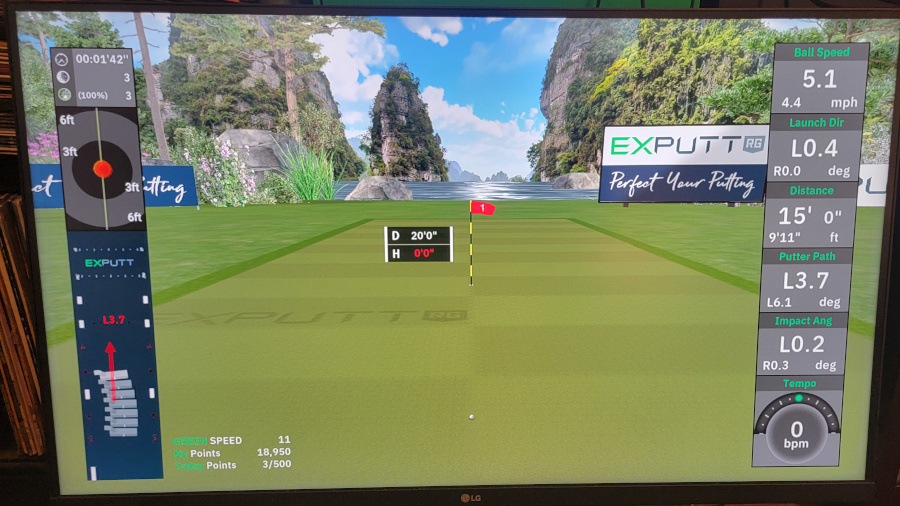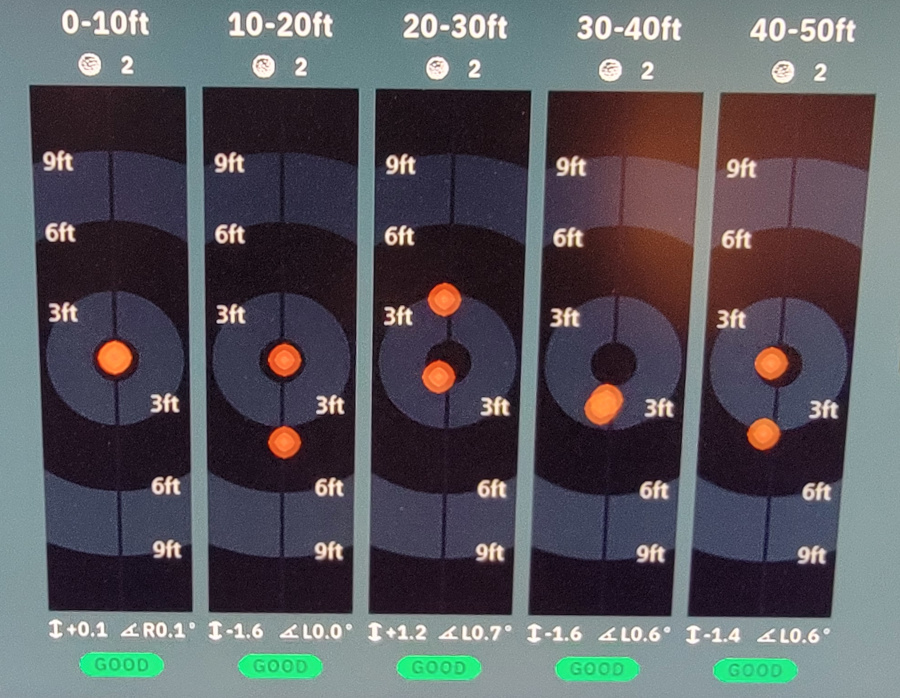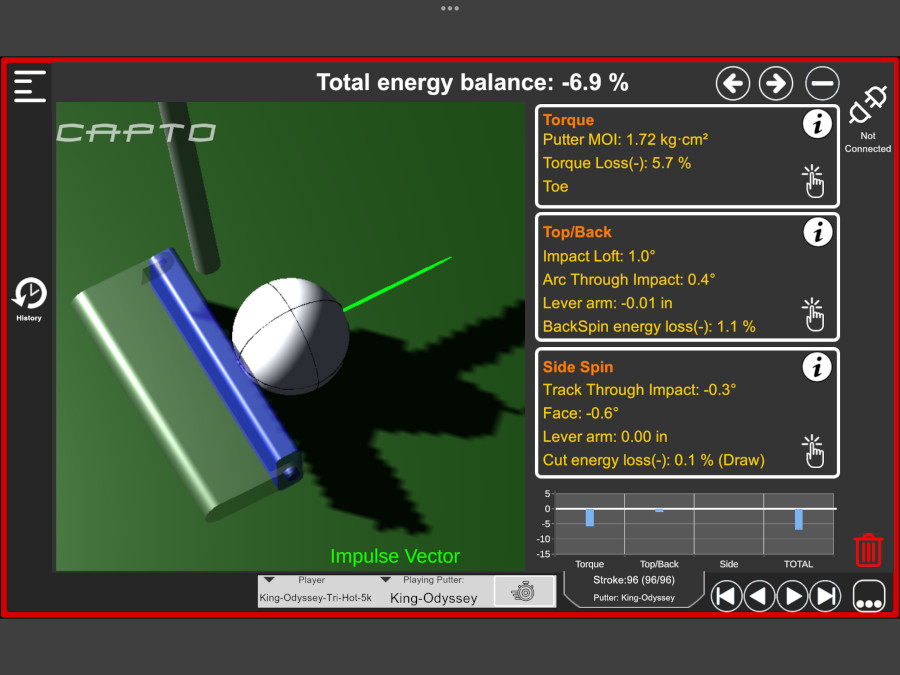Energy Loss when putting can occur if one or several putting metrics are not optimal. Example: Your centeredness of contact is off causing you to leave the ball short. Let’s take a look at potential culprits.
I’ve been gathering various putting devices and software to measure my putting metrics for a couple years now.
If you aren’t measuring in golf, you are guessing.
Just to come up with an good example for this article, I attempted 10 putts this morning from 5 to 50 feet.
The good news was I made the first 3 the putts from 5, 10, and 15 feet and was very close from 20 to 50 feet.
See the images below for the summary of those putts from my EXPUTT RG putting simulator.

The image above is from a made 15 foot putt.
Based on the metrics it just barely went in the hole. Why?
If this was a perfect putt, all the launch metrics would read zero point zero. They do not.
Look at the right hand column.
The face angle at impact is almost perfect at 0.2 left. That is 95% of the reason it went in.
The path is left 3.7 degrees which is 5% of the total.
The total launch direction is Left 0.4 degrees (0.2 +0.185 = rounded up Left 0.4)
How far can your face angle and launch be off. From the Visio Aim Board: 5 foot make is < 2 degrees off, 10 foot is < 1 degree off, and 15 foot make is <0.5 degrees off.
The longer the putt, your face angle, path and total launch angle must be exact.
Pros start missing 50% of their putts at 8 feet. So, don’t beat yourself up too bad.
In this case, the path going left put side spin on the putt which could have made it miss. That’s energy loss.
Because the speed, face angle at impact and path were were pretty good, the putt went in.
Summary 10 putts – EXPUTT RG

Three putts went in, two were10 feet or less
That’s why there are only 9 dots
You really need to have your face angle and path add up to being under 0.5 degrees total launch direction or less for all of these.
Effectively, the farther away you get, the smaller the hole and margin for error gets.
I can tell you that it takes practice to accomplish this for all 10 distances. I would take this result all day long.
If you look at the numbers under each column it gives you the average angle and amount off for that category.
Just to summarize, from 0 to 20 feet I was real good. After that I was over 0.5 degrees launch direction total value. Also, several putts are short.
That points to an obvious energy loss. It was most likely speed control.
However if you look at the putts, they either went in or were touching the 3 foot circle. That’s pretty good. Two of them look like they came close, but lipped out.
Other Factors in Energy Loss
The following mage is a screen shot from a made 6 foot putt as shown on the Energy screen from the CAPTO Gen 3 system and software.

I like to keep the energy loss under minus 10 percent
The closer to zero the better
Starting on the top right, the major culprit is an off center contact with the ball. It clearly says toe hit causing a 5.7 percent energy loss.
The second row down says I added 1 degree of loft causing backspin energy loss of 1.1 percent.
Side spin caused another 0.1 percent energy loss.
The total energy loss was 6.9 percent.
The major malfunction was centeredness of contact.
Conclusion
Again, if you aren’t measuring in golf you are guessing.
I practiced for a couple years with BLAST GOLF. It measures a ton of metrics. If you can only afford one device and app, I would highly recommend it.
However, it’s not all the information I like to have. Example: It measures change of face angle, lie, etc., but doesn’t tell you what any of that was at address before you attempted the putt. It simply measures metrics during the putt. Not at address.
EXPUTT RG doesn’t tell you where you started either, but gives you the advantage of putting indoors and at long distance compared to a putting mat.
You do get a sense of energy loss from EXPUTT RG because the putt either goes in or it doesn’t. You can tell if you where short or long, left or right for example. It’s a simulator.
CAPTO is a whole different deal. It does tell you what your face angle and lie angle are at address and then again at impact for example.
There are at least 16 metric tiles on the main screen. That is just a rough description. There is a lot more information available.
The CAPTO Gen 3 system and BLAST MOTION GOLF work great with a PuttOUT mat and premium pressure trainer or the PuttOUT Airbreak. You can at least see that the putt was made or not.
The best option is the practicing on the putting green. The CAPTO Gen 3 system or Blast Motion Golf work outside as well.
Speed control is number one when it comes to putting. Face angle at impact is number 2 in importance.
Start Line and Green Reading are important as well.
This article is just about ways I’ve tried to measure my energy loss and energy balance.
In my case, the cause of a short putt is almost always an off center putter contact with the ball.
I can tell as soon as I putt now if it’s going to be short, long, left or right.
It’s a great idea to practice during the winter so you are ready when the season starts.
Note: These different measuring devices are setup by the manufacturer. I’ve seen most people say “face angle at impact” is 90% of the start line accuracy and path is 10%. I’ve also seen people say face angle at impact is 80%. All of these are very close and none are 100% identical. I bring this up because of the 95% plus 5% calculation made by the EXPUTT RG when it comes to Launch Direction.
